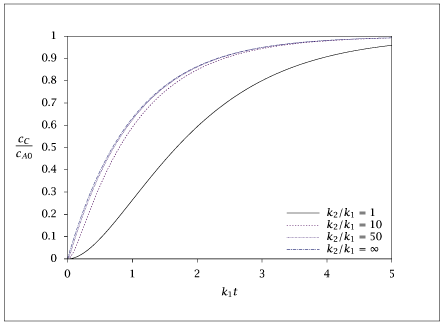% Copyright (C) 2001, James B. Rawlings and John G. Ekerdt
%
% This program is free software; you can redistribute it and/or
% modify it under the terms of the GNU General Public License as
% published by the Free Software Foundation; either version 2, or (at
% your option) any later version.
%
% This program is distributed in the hope that it will be useful, but
% WITHOUT ANY WARRANTY; without even the implied warranty of
% MERCHANTABILITY or FITNESS FOR A PARTICULAR PURPOSE. See the GNU
% General Public License for more details.
%
% You should have received a copy of the GNU General Public License
% along with this program; see the file COPYING. If not, write to
% the Free Software Foundation, 59 Temple Place - Suite 330, Boston,
% MA 02111-1307, USA.
% This program "schm1_conc.m" generates curves for the final product in
% a series problem as the rate constant ratios for the first and
% second first-order reactions are varied.
% Last edited 1/30/97.
%
% Revised 7/24/2018
p = struct(); % Create structure to pass parameters to ode15s function
p.k1 = 1.0;
p.k2 = 1.0;
Initial = [1,0,0]';
t = [0:.01:5]';
opts = odeset ('AbsTol', sqrt (eps), 'RelTol', sqrt (eps));
[tsolver, solution] = ode15s(@(t,x) rxrate(t,x,p),t,Initial,opts);
answer = [t solution];
p.k2 = 10.0;
[tsolver, solution] = ode15s(@(t,x) rxrate(t,x,p),t,Initial,opts);
answer = [answer solution];
p.k2 = 50.0;
[tsolver, solution] = ode15s(@(t,x) rxrate(t,x,p),t,Initial,opts);
answer = [answer solution];
c_Css = 1 - exp(-p.k1*t); %solution for k2 = Inf
answer = [answer c_Css];
save -ascii schm1_conc.dat answer;
if (~ strcmp (getenv ('OMIT_PLOTS'), 'true')) % PLOTTING
plot (answer(:,1),[answer(:,4),answer(:,7), ...
answer(:,10),answer(:,11)]);
% TITLE
end % PLOTTING
